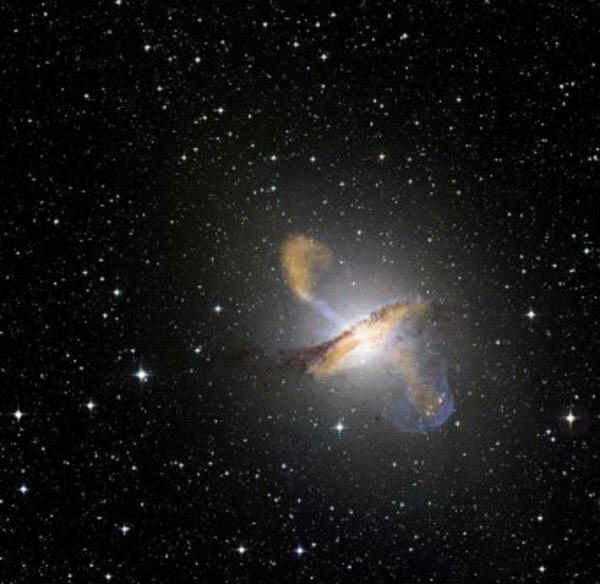|
|
Seeing Down Tunnels
Feb 09, 2009
Most modern telescopes, such as the
Hubble Space Telescope, are
afflicted with “tunnel vision”:
their fields of view are extremely
narrow.
In this they reflect
the mindset of the astronomers who
use them. The narrow vision is
justified by the assumption that
celestial objects are isolated, and
the assumption is justified by the
vision that excludes outlying
objects. As one pundit has remarked,
“Inside this circular cage of logic
the gerbil of astrophysics begins to
run.”
An example is Centaurus A (Cen A), a
nearby active galaxy that was the
first radio source discovered at the
end of World War II, when no
astronomer imagined that radio waves
could come from the sky. A recent
composite image (above) shows the
dusty disk around the equator and
the radio lobes and x-ray jets along
the axis.
What it doesn’t show are the radio
lobes and braided emission filaments
that extend along the axis for
almost 10 degrees across the sky.
Stretching twice as far along the
same line are a dozen other active
galaxies—Seyferts, spirals, and
ellipticals—that have redshifts
ranging from slightly more than Cen
A to 250 times as much and more.
If the Hubble effect truly indicated
an expanding universe, these
galaxies would be scattered as
isolated bodies from 13 million
light-years away to nearly 2 billion
light-years away. Their alignment
would have to be coincidental—a
coincidence that borders on
impossible.
Another thing that the image doesn’t
show is the “supermassive black
hole” that astronomers assume must
be there to generate all the
energetic phenomena that they see:
speeds in the jets of half the speed
of light, copious synchrotron
radiation, strong magnetic fields,
and shock waves. That the energetic
phenomena could be caused by another
mechanism lies outside the field of
their imaginations.
The image does show several clues to
such another mechanism: The dust
lane is filamented, and the
filaments appear to be braided,
especially at the left and right
extremities. This is a
characteristic of electric currents
in plasma, called
Birkeland currents. Tiny twisted
hair-like structures extend
perpendicularly from the disk. These
are typical of
coronal discharges from
high-voltage currents.
The axial discharges along with the
equatorial disk mark out the
structure of Alfvčn’s proposed
galaxy circuit that would power
a plasma focus mechanism in the
core. That mechanism would
repeatedly eject highly charged
high-redshift plasmoids along the
axis. As each plasmoid moves toward
charge equilibrium, its mass would
increase and its redshift would
decrease until it
evolves into a companion
galaxy—as is occurring along the
line of ejected objects.
Such an explanation that encompasses
a view of actual plasma behavior
would correct the presently accepted
myopia that refuses to see what’s
there and insists on seeing what
isn’t.
By Mel Acheson
|
|
|
|
|
|
SPECIAL NOTE - **New Volumes Available:
We are pleased to announce a new
e-book series
THE UNIVERSE ELECTRIC. Available now, the first volume
of this series, titled Big Bang, summarizes the failure of modern cosmology
and offers a new electrical perspective on the cosmos. At
over 200 pages, and
designed for broadest public appeal, it combines spectacular
full-color graphics with lean and readily understandable
text.
**Then second and third volumes in the series are now available,
respectively titled Sun and Comet, they offer
the reader easy to understand explanations of how and why these bodies
exist within an Electric Universe.
High school and college students--and teachers in
numerous fields--will love these books. So will a large
audience of general readers.
Visitors to the Thunderbolts.info site have often
wondered whether they could fully appreciate the Electric
Universe without further formal education. The answer is
given by these exquisitely designed books. Readers from
virtually all backgrounds and education levels will find them
easy to comprehend, from start to finish.
For the Thunderbolts Project, this series is a milestone.
Please see for yourself by checking out the new
Thunderbolts Project website, our leading edge in
reaching new markets globally.
Please visit our
Forum
|
|
|
|
|
|
|
|







